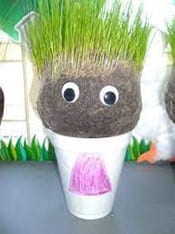B ackground: If you can’t sleep, count sheep….Why do we count sheep to go to sleep? Is this just an old wive’s tale to help us fall fast asleep? Perhaps, we remember stories from centuries ago that tell us how shepherds counted their herds of sheep every night before bedtime. Legend has it, knowing that all their sheep were in a safe place relaxed and calmed the shepherds, allowing them to fall asleep quickly.
ackground: If you can’t sleep, count sheep….Why do we count sheep to go to sleep? Is this just an old wive’s tale to help us fall fast asleep? Perhaps, we remember stories from centuries ago that tell us how shepherds counted their herds of sheep every night before bedtime. Legend has it, knowing that all their sheep were in a safe place relaxed and calmed the shepherds, allowing them to fall asleep quickly.
Sheep are multi-purpose animals; they can give us meat, milk, and wool. With today’s lesson, we are going to explore more about wool. The wool from one individual sheep is called fleece, while wool from many sheep combined together is called a clip. Wool can come in different forms depending on the sheep. Long wool sheep have the heaviest fleece; it is normally long and coarse. Medium wool sheep grow a lighter weight fleece, while fine wool sheep produce the more valuable, smaller fiber wool that is less likely to itch when made into clothing. Wool can be used for clothing, rugs, hats, carpets, blankets, yarn, felt, socks and so much more. However, there is a greater demand for wool than the sheep can produce. To solve this problem, we have to turn to technology. In the 1980’s, textile researchers at Malden Mills in Lawrence, Massachusetts experimented with a fur like fabric made from polyester. The product was called “polyester fleece” or “polar fleece.” Polyester fleece is extremely warm due to its structure, which allows a space for air pockets between the threads. This polyester fleece can be found in many everyday clothing products.
We are thankful to sheep for giving us wool and science for developing polar fleece which meets so many of our daily needs. As part of our lesson we are going to learn about giving to our community, our loved ones, and people in need. Just like service is a big part of being in 4-H, many careers involve giving back to the community. Today we will explore service career options and use polar fleece by making a no-sew blanket, which we will give to someone in need. We will also make heart pillows to take home that remind participants of the careers we will explore and the feeling youth experience by giving to someone in need.
Local Career Connections:
Careers to discuss that provide community service needs:
- Caregivers: Social Worker, Counselors, Senior Care, Child Care, Health Care.
- Emergency Responders: EMS Personnel, Nurse, Firefighter, Emergency Room Doctors.
- Environmental: Scientists, Engineers, Conservationists, Park Rangers, Government Agencies, Foresters.
- Community Organizations: Homeless Shelters, Animal Shelters, Food Pantries, Drug Rehabilitation Centers, Veterans Organizations, Crisis Counselors, Educators.
Science Behind :
Polar Fleece, or polyester fleece is a synthetic or man-made material that has been used to make underwear for astronauts, deep sea diving suits and even ear-warmers for winter-born calves. Due to its light-weight make up and ability to hold heat, it is perfect for cold weather clothing. You would never guess that it is made from recycled plastic bottles! First, the plastic bottles are shredded into small chips, then sorted by color and cleaned. Next, the plastic chips are dried in a large oven, until all moisture is removed. Then the plastic is melted into a dense liquid that is pushed through a showerhead-like nozzle which forms a thread like structure. At this point, the thread is still weak so it is heated, combined, and stretched to increase the strength. The final process is to tear apart or crimp the thread so that it looks like fabric. At this point, the short, fluffy, hairy fibers look very much like wool. The fibers are then inspected and sent to a carding machine where it is made into rope-like strands called fleet. The thick ropes are then fed into a spinning machine and twisted into a much finer diameter, and the yarn is collected on a large spool. Next, the circular knitting machine weaves the yarn into a continuous tube of cloth. To make the material fuzzy, it needs to run through bristles which are called the napper which makes little loops. It is then sent to the shearing machine to be trimmed, and smoothed out, giving it the fluffy feeling we enjoy. Once the plastic is completely transformed into cloth, the manufacturer will cut and sew the cloth into a garment.
What to Do: (Depending on time or skill level of participants, the instructor could pre-cut the heart patterns.)
Step 1: Cut squares large enough for your heart pattern. Place two of the fabric pieces together and trace your heart pattern with  chalk.
chalk.
Step 2: Cut both pieces of fabric along the chalk pattern.
Step 3: Trace a smaller heart pattern within the large heart. Be sure to leave at least 2-3 cm between the two borders. See pattern enclosed with lesson. Heart Pillow Pattern-zq8odw
Step 4: Cut small strips around the heart, making sure they are long enough to tie. The strips can be about half an inch wide.
Step 5: Tie the two pieces together in a knot. Once you have most of the knots tied, stuff the heart with stuffing or cotton. Finish tying the rest of the knots.
Step 6: Optional- Trim the knot strips around the heart.
Go Over Findings:
Investigate, Create, & Take: Investigators can take with them:
- Small Heart Pillow
- Service Career Options
Additional add on activities:
- Bring in samples of real fleece, wool clothing or other wool products.
- Show pictures of sheep, goats, llamas or other animals that are also used for fiber products.
- Visit a sheep farm, or have a lamb visit the classroom.
Sources:
Real men wear wool, Sheep101.info, http://www.sheep101.info/wool.html
How Products are Made, Polyester Fleece, http://www.madehow.com/Volume-4/Polyester-Fleece.html
How It’s Made-Wool, https://www.youtube.com/watch?v=uEYsmzophTA
How It’s Made Recycled Polyester Yarn, https://www.youtube.com/watch?v=uEYsmzophTA
Developed and Reviewed By:
Tiffany Sanders Riehm, Gallia County 4-H Program Assistant, Ohio State University Extension 4-H Youth Development, riehm.11@osu.edu. Tracy Winters, Gallia County 4-H Extension Educator, Ohio State University Extension 4-H Youth Development and Michelle Stumbo, Meigs County 4-H Extension Educator, Ohio State University 4-H Youth Development
 plants is an activity that has success happening right before your eyes! Plants need five things to grow: light, water, air, nutrients, and the proper temperature. Light is absorbed by the plant causing it to produce food that is utilized by the plant for growth. We all need food and water so make sure you are providing adequate water to the plant. Air is vital to provide carbon dioxide for making that food and making sure our environment is an acceptable temperature for growth. Most plants are not excited about frosty mornings, so covering outside plants is a must for those with flowers, bushes, and vegetables until May 15. Nutrients are the last thing that is necessary for plant growth and is typically provided in the soil and absorbed into the plant through the roots.
plants is an activity that has success happening right before your eyes! Plants need five things to grow: light, water, air, nutrients, and the proper temperature. Light is absorbed by the plant causing it to produce food that is utilized by the plant for growth. We all need food and water so make sure you are providing adequate water to the plant. Air is vital to provide carbon dioxide for making that food and making sure our environment is an acceptable temperature for growth. Most plants are not excited about frosty mornings, so covering outside plants is a must for those with flowers, bushes, and vegetables until May 15. Nutrients are the last thing that is necessary for plant growth and is typically provided in the soil and absorbed into the plant through the roots.


















